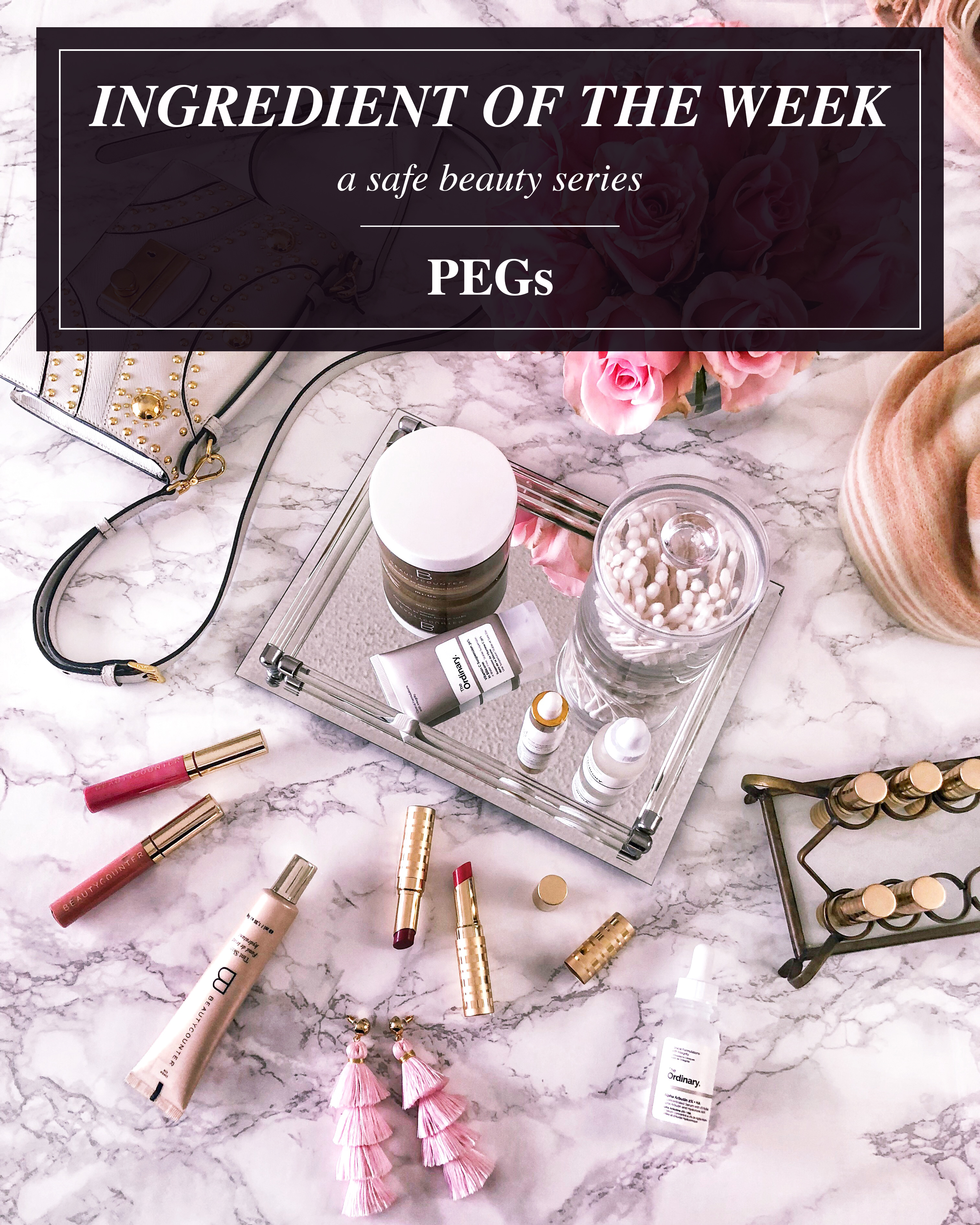
For this week’s Ingredient of the Week post I’m talking about PEGs! They’re another commonly found chemical in moisturizers, sunscreens, and shampoo so make sure to read the back of your current products. PEGs are often contaminated with toxic impurities which is why I’m writing about them in this series. So, what are PEGs and what do they do?
If you missed the intro to this series, it explains what “safe beauty” is, and why it’s important. The quick version is that the FDA doesn’t regulate what chemicals brands put in their products and it doesn’t set standards for words like “natural” or “organic”. Basically, a brand could put “natural” on a container full of carcinogens if they wanted (and they often do). So let’s learn more about PEGs .
What to look for.
PEG is short for polyethylene glycol. It will some times be spelled out on labels. However, in most of the instances I’ve found, it is abbreviated as PEG and then followed by a dash with a number.
PEG-6
PEG-8
PEG-100
Polyethylene Glycol
Any time you see PEG, it’s part of this same family. In case you were wondering, the number is the molecular weight. Lower weights are better able to penetrate the skin so you’ll see lower numbers in your skincare products.
What are PEGs?
PEGs are used to thicken products like creams, lotions, and anything that carries a lot of moisture. PEGs are also emollients that help soften and lubricate the skin. They are also used to help penetrate the skin so that other chemicals can get deeper into our pores. They act as solvents – everyone knows that water and oil don’t mix. Solvents help both ingredients mix together.
Why do brands use PEGs?
Just like phthalates, PEGs make it easy for brands to create products that have the consistency that we, as consumers, expect. On most occasions, you probably don’t expect to open your product and see that the ingredients have separated! The other benefit of PEGs is that some (especially the lower number) are able to penetrate the skin so well. If the PEGs are penetrating your skin well, it’s likely that the other active ingredients are also penetrating your skin. That results in a more effective product which leads to better sales (and is what we all want)!
With PEGs, the chemical impurities found in PEGs are what endangers your health the most. Responsible manufactures do make an effort to remove the impurities (like 1,4-dioxane which is a carcinogen) however, most companies have not shown an interest in doing so. When you see a PEG on a label, it’s important to know if the brand is respectable or clean beauty focused since you can’t know from the label if the PEG is contaminated with impurities. When it doubt, just find an alternative.
What products usually contain PEGs?
PEGs are found in almost every kind of product from night creams, to St. Ives Apricot Scrub, to shampoo. Since they are so widely used, you have to check every category of personal care products! There’s a very good chance you’ll find them in your lotions and serums though as those products are designed to penetrate your skin the most!
What PEGs do to you.
So here’s the tricky part. PEGs are often contaminated with chemical impurities like ethylene oxide or 1,4-dioxane which are both carcinogens. They can also be contaminated with a long list of other toxins including heavy metals. A fun fact I learned was ethylene oxide is highly toxic and was used as nerve gas in WWI. The Organic Consumer Association did a study that found that 46 out of 100 personal care products that were listed as “organic” or “natural” contained PEGs with 1,4-dioxane. That’s insane! It also goes to show you that the words “organic” and “natural” don’t mean anything in terms of your safety!
Cancer. Exposure to the impurities in PEGs such as ethylene oxide has been linked to higher instances of leukemia and several types of cancer. Since many of the chemical impurities are carcinogens, this makes sense. It’s also been linked to tumors (liver, kidney, and skin).
Kidney failure. Ethylene glycol and its ethers are toxic to kidneys when applied to damaged skin.
Skin, eye, and lung irritation. PEGs often cause rashes and dermatitis or even worse: hives. They tend to rob your skin of its moisturizer and disrupt the oil production of your skin. This makes skin more susceptible to the toxins in PEGs and in any product. These chemicals are especially toxic when your skin has already been damaged like acne or abrasions. Ethylene oxide has been shown to irritate eyes and cause corneal damage and can cause the accumulation of fluid in your lungs.
Some safe alternatives.
Since PEGs are found in so many products, I’d recommend checking out my nighttime skincare post and my morning makeup routine for starters! I’ve also listed out my favorite Beautycounter products (one of the brands that I know has banned PEGs in their products) here. If you currently use St. Ives Apricot Scrub and are looking for another good exfoliator, I shared 2 options in this post!
Have you found PEGs in your products? Do you have any favorite PEG-free products? Please share!
Nice post